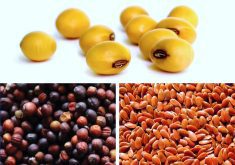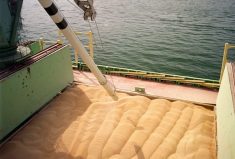ICE Futures Canada’s canola futures bounced around during the week ended March 19, setting fresh contract lows in the nearby months before eventually recovering to post modest advances in the most actively traded nearby contracts. However, the new-crop months remained down on the week, with expectations for increased acres this spring behind some of the selling. The strength of the Canadian dollar, which moved ever closer to parity with its U. S. counterpart during the week, accounted for some of the weakness in canola – although the currency did fail to hold above the US99-cent level. The ongoing harvest of a record South American soybean crop also weighed on values. However, the losses encouraged some end-user demand, which helped prop up prices. Short-covering on oversold price sentiments was also evident in canola.
Read Also

Brazil muscles into wheat market
Glacier FarmMedia – Canadian wheat exporters are facing a new competitor in their second biggest market. “The rapid emergence of…
ICE’s barley futures remained largely untraded during the week, with commercial positioning in the thin market putting some pressure on prices. Barley cash bids held reasonably steady during the week, as feed supplies in Western Canada remain more than sufficient and end users are only buying on a hand-to-mouth basis.
In the U. S., soybeans were higher during the week, as the market saw a short-covering bounce off of recent lows. Talk of potential disruptions to South American soybean exports was also supportive. However, Brazil and Argentina are still expected to harvest record crops that will eventually find their way into the export channels, and those large supplies overhanging the market helped offset any concerns about nearby movement. Ideas that U. S. soybean acres will end up larger than originally thought also tempered the upside. Some private forecasts had planted area up by a million acres or more on the year.
The U. S. dollar index was stronger during the week, which tempered the advances in the U. S. grain and oilseed markets.
Corn prices also benefited from a short-covering correction during the week. While the looming South American harvest was a limiting factor in the corn market as well, any increase in U. S. soybean plantings would come at the expense of corn, which was supportive for prices.
The U. S. Department of Agriculture releases its first official estimates of 2010 U. S. acres on March 31, and the futures markets should expect to see some choppy, position-evening trade ahead of that report.
U. S. wheat prices were lower across the board. While an attempt at a short-covering bounce was made, the fact remains that world wheat supplies are large and U. S. prices are too expensive to compete in the international market. Wet U. S. soil conditions, which could cut into corn acres and increase soybean plantings, helped limit the downside in wheat, given ideas that spring wheat area could also see reductions given the moisture situation.
Too soon to say?
For all of the talk about wet fields disrupting seeding, there are also analysts of the opinion that it’s still much too early to be concerned about planting delays, both in the U. S. and Canada. They also make the point that the moisture will be good for the crops in the long run, helping boost yields.
That “excessive moisture” being talked up in the markets led to both Fargo and Grand Forks, along the Red River in North Dakota, declaring states of emergency during the week. The river is cresting earlier than normal, and farmers along the flood plain will be facing soggy fields once again this year.
However, while the potential for a late-season blizzard or heavy rain is still there, the fact that the flooding will happen earlier than normal and be smaller than last year should bode well for crop production. In 2009, a large number of acres along the Red River were left unseeded, but if the water subsides in good time this year, that land should be in better shape this year.
It’s worth noting that in 1997, the year of the “Flood of the Century,” the conditions over the rest of the summer turned out rather favourably for the crops. In addition, while it’s wet in the Red River Valley, the Prairies get considerably drier moving west, with drought-like conditions being reported in parts of Saskatchewan and Alberta.
So even if the U. S. does plant more soybeans and less corn, what does it mean for the markets, if that corn still ends up showing record yields? Or what if the soybeans run into an early frost? Or what if all the talk of increasing canola acres causes contrarian producers to switch to something else?
For three-times-daily market reports from Resource News International, visit “ICE Futures Canada updates” at www.albertafarmexpress.ca
The futures and cash markets will keep bouncing around in attempts to answer those questions as they come up, and in the meantime the best advice I’ve heard is that producers should watch for those opportunities that work for their individual bottom line. Prices will go higher or lower, but will they be profitable? We’ll see.
Phil Franz-Warkentin and Dwayne Klassen write for Resource News International (RNI), a Winnipeg company specializing in grain and commodity market reporting.















